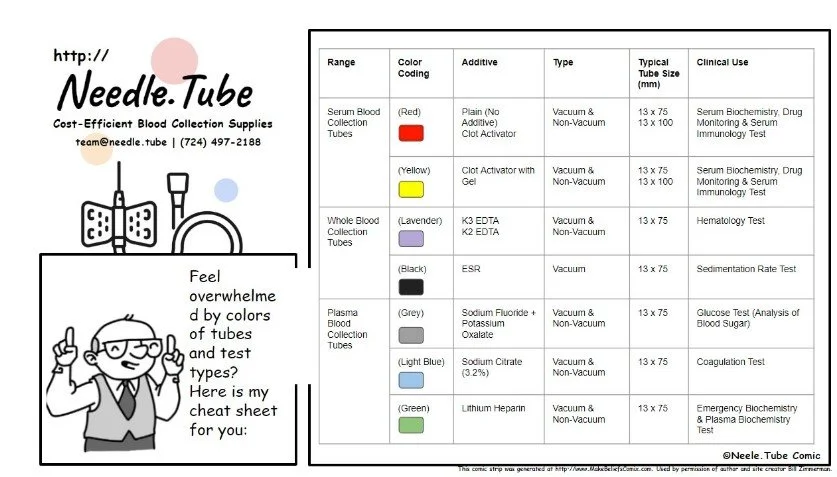Guide For Blood Draw Tube Colors
Introduction
Phlebotomy, the practice of drawing blood from a patient for clinical or medical testing, requires the use of different colored tubes to collect and store blood samples. Each tube color represents a specific additive or anticoagulant used in the sample collection process. In this guide, we will discuss the different blood draw tube colors and their significance in phlebotomy procedures.
Blood Collection Tube Color Chart
Understanding Blood Draw Tube Colors
Lavender or Purple Top Tubes
Lavender or purple top tubes are commonly used for complete blood count (CBC) tests and blood cell identification. The tube contains the anticoagulant EDTA (ethylenediaminetetraacetic acid), which prevents blood clotting by binding calcium ions. It is essential to mix the blood with the EDTA immediately after collection to ensure accurate test results.
Light Blue Top Tubes
Light blue top tubes are used for coagulation studies such as prothrombin time (PT) and activated partial thromboplastin time (aPTT) tests. These tubes contain sodium citrate, which binds calcium ions to prevent blood clotting. It is crucial to maintain the proper blood-to-additive ratio for accurate coagulation testing results.
Green Top Tubes
Green top tubes, also known as mint green tubes, contain the anticoagulant heparin for tests that require plasma, such as chemistry panels and electrolyte testing. Heparin inhibits thrombin formation and prevents blood clotting by activating antithrombin. These tubes are available in lithium, sodium, or ammonium heparin formulations.
Red Top Tubes
Red top tubes do not contain an anticoagulant and are used for serum testing, which requires a clot to form before analysis. These tubes are suitable for tests such as blood glucose, cholesterol, and hormone levels. After drawing blood, allow the sample to clot for 30 minutes before centrifugation to separate the serum from the blood cells.
Gold or Tiger Top Tubes
Gold or tiger top tubes have a gel separator and clot activator for serum testing. The gel separator forms a barrier between serum and blood cells during centrifugation, preventing contamination. These tubes are commonly used for chemistry panels, liver function tests, and infectious disease screening.
Gray Top Tubes
Gray top tubes contain the anticoagulant sodium fluoride and potassium oxalate for glucose testing. Sodium fluoride inhibits glycolysis, while potassium oxalate acts as an anticoagulant. These tubes are essential for accurate glucose measurements, as glycolysis can lead to falsely decreased glucose levels in the sample.
Pink Top Tubes
Pink top tubes are used for blood bank testing and contain the anticoagulant EDTA or potassium ethylenediaminetetraacetic acid (K2EDTA). These tubes are essential for blood typing, cross-matching, and antibody screening in transfusion medicine. It is crucial to properly mix the blood with the anticoagulant to prevent clotting.
Tips for Blood Draw Tube Collection
Always check the expiration date on the blood draw tubes before use.
Verify the patient's identity and the order of draw to prevent sample contamination.
Properly label each tube with the patient's name, date of birth, and time of collection.
Follow standard phlebotomy protocols for venipuncture and blood collection.
Handle the blood draw tubes carefully to avoid breakage or contamination.
Conclusion
Understanding the significance of blood draw tube colors is essential for accurate sample collection and testing in phlebotomy procedures. Each tube color represents a specific additive or anticoagulant used in the sample collection process, and it is crucial to follow proper handling and mixing techniques to ensure reliable test results. By following this guide, phlebotomists can enhance the quality and efficiency of blood collection procedures for improved patient care.

Disclaimer: The content provided on this blog is for informational purposes only, reflecting the personal opinions and insights of the author(s) on phlebotomy practices and healthcare. The information provided should not be used for diagnosing or treating a health problem or disease, and those seeking personal medical advice should consult with a licensed physician. Always seek the advice of your doctor or other qualified health provider regarding a medical condition. Never disregard professional medical advice or delay in seeking it because of something you have read on this website. If you think you may have a medical emergency, call 911 or go to the nearest emergency room immediately. No physician-patient relationship is created by this web site or its use. No contributors to this web site make any representations, express or implied, with respect to the information provided herein or to its use. While we strive to share accurate and up-to-date information, we cannot guarantee the completeness, reliability, or accuracy of the content. The blog may also include links to external websites and resources for the convenience of our readers. Please note that linking to other sites does not imply endorsement of their content, practices, or services by us. Readers should use their discretion and judgment while exploring any external links and resources mentioned on this blog.

